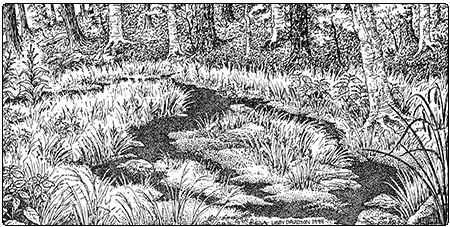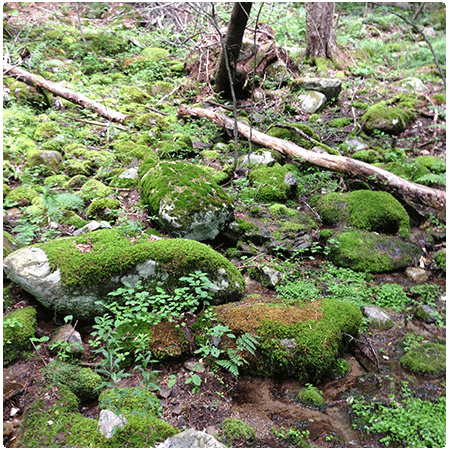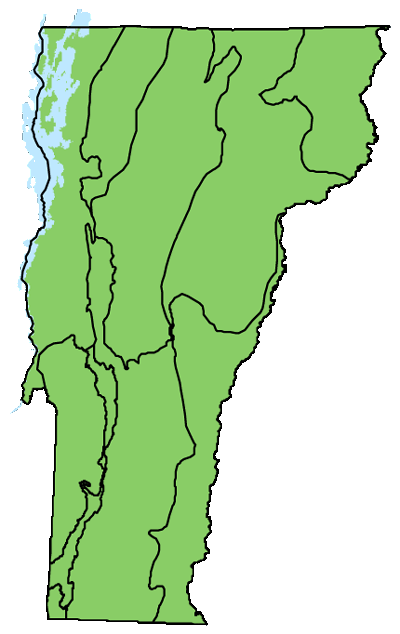Ecology and Physical Setting
Woodland Seeps are small wetlands with moving water and lush herbs, a delightful contrast with the surrounding upland forests. Despite their small size, they contribute disproportionately to biological diversity, provide important wildlife habitat, and send a steady flow of cold, clean water into streams and rivers. Seeps are often the headwaters of perennial streams and have traditionally been used as sites for the construction of spring boxes for household water supplies.
Seeps occur where groundwater emerges, usually at the base of slopes, in coves, or on benches. In these topographic settings, there is usually a sub-surface layer of bedrock or hardpan that impedes the downward movement of groundwater, resulting in horizontal flow and discharge of water at the surface. Seeps are typically long and narrow with a total area less than one half acre. It is common to find numerous seeps aligned along a similar elevation and topographic break.
 Groundwater discharge provides a constant supply of water to Woodland Seeps. This flow continues through the driest summer months, and in winter, warms the soil and prevents freezing. Groundwater in our region is typically about 47oF and varies only a few degrees from this temperature. The nearly constant supply of 47oF water at the upper edges of seeps typically results in early spring growth of herbs. This early spring vegetation can be an important source of food for black bears emerging from their winter sleep. When seeps occur along larger streams and rivers, they help moderate water temperature extremes.
Groundwater discharge provides a constant supply of water to Woodland Seeps. This flow continues through the driest summer months, and in winter, warms the soil and prevents freezing. Groundwater in our region is typically about 47oF and varies only a few degrees from this temperature. The nearly constant supply of 47oF water at the upper edges of seeps typically results in early spring growth of herbs. This early spring vegetation can be an important source of food for black bears emerging from their winter sleep. When seeps occur along larger streams and rivers, they help moderate water temperature extremes.
As a result of variation in soil saturation and the well-oxygenated water, thin surface organic layers develop over mineral soils. The chemical composition of groundwater flowing into seeps is closely related to bedrock and surficial deposits. Water with high concentrations of dissolved calcium will result from contact with limestone and calcareous schists, while water lower in dissolved minerals results from contact with granite or other acidic rocks. The variations in water chemistry affect the flora and fauna of Woodland Seeps.
Vegetation
Trees and shrubs are usually absent from Woodland Seeps, although most seeps are so narrow that they are well shaded by the overhanging canopy of the adjacent upland forest. Occasional trees may also be found in the seeps themselves, but seeps are generally too wet to support trees.

Woodland Seep, as well as in Seepage forests.
Herbs are lush and dense. Characteristic species include rough-stemmed sedge, slender mannagrass, golden saxifrage, swamp saxifrage, water pennywort, and spotted touch-me-not. Other species that may be abundant include sensitive fern, false hellebore, swamp buttercup, and wood nettle. Bryophytes, which may be abundant, typically include Brachythecium rivulare, Rhizomnium punctatum, and common fern moss.
Wildlife Habitat
Three species of salamanders are closely associated with Woodland Seeps. Northern dusky salamanders thrive in the saturated mucky soil and mossy cover. Spring salamanders and northern two-lined salamanders are more likely to be found in the small streams originating from groundwater discharge, but also in the adjacent Woodland Seeps. Both black bear and American woodcock seek out seeps in the early spring—bears to feed on the flush of herbaceous vegetation and woodcocks to probe for invertebrates in the groundwater-thawed soils. Woodland Seeps and their associated streams also support the rare arrowhead spiketail dragonfly, as well as the more common eastern red damsel and delta-spotted spiketail.
Variants
- High-Elevation Seeps are found above 2,500 feet in elevation. They vary from herbaceous to shrubby. Frequent species include balsam fir, mountain maple, choke cherry, mountain wood fern, tall meadow rue, spotted touch-me-not, and false hellebore. These can be larger and sunnier than typical Woodland Seeps; they are not always completely shaded by the adjacent forest canopy.
Related Communities
- Northern Hardwood Seepage Forest: While Woodland Seeps are usually small and isolated, seepage forests are extensive. Northern Hardwood Seepage Forests contain a fine-scale mosaic of upland and wetland, and the wet hollows share many species in common with Woodland Seeps. The forest or woodland canopy is dominated by upland species such as sugar maple and yellow birch, but black ash, a wetland species, can be abundant.
Conservation Status and Management Considerations
Woodland Seeps are threatened by alteration of the quality or quantity of groundwater discharge resulting from development in the associated groundwater recharge area. They are also threatened by logging with heavy machinery either in the seep itself or in its immediate vicinity. The mucky surface organic soils may not freeze during the winter because of the constant input of relatively warm groundwater, and heavy machinery can create deep ruts that alter the hydrology and disturb resident amphibians. Machinery should be kept out of Woodland Seeps and their forested buffers.
Distribution/Abundance 
Woodland Seeps are common and widespread throughout Vermont. They are known to occur throughout the northeastern United States and adjacent Canada.
Characteristic Plants
Herbs
Abundant Species
Rough-stemmed sedge – Carex scabrata
Slender mannagrass – Glyceria melicaria
Spotted touch-me-not – Impatiens capensis
Occasional to Locally Abundant Species
Golden saxifrage – Chrysosplenium americanum
Swamp saxifrage – Micranthes pensylvanica
Water pennywort – Hydrocotyle americana
Sensitive fern – Onoclea sensibilis
False hellebore – Veratrum viride
Swamp buttercup – Ranunculus hispidus var. caricetorum
Drooping woodreed – Cinna latifolia
Wood nettle – Laportea canadensis
White turtlehead – Chelone glabra
Jack-in-the-pulpit – Arisaema triphyllum
Foamflower – Tiarella cordifolia
Nodding sedge – Carex gynandra
Fowl mannagrass – Glyceria striata
Water avens – Geum rivale
Marsh blue violet – Viola cucullata
Northern white violet – Viola pallens
Northern willow-herb – Epilobium ciliatum
Wood nettle – Laportea canadensis
Dwarf enchanter’s nightshade – Circaea alpina
Purple-stemmed aster – Symphyotrichum puniceum
Bog-candles – Platanthera dilatata
Small purple fringed orchis – Platanthera psycodes
Skunk cabbage – Symplocarpus foetidus
Bryophytes
Occasional to Locally Abundant Species
Moss – Brachythecium rivulare
Moss – Rhizomnium punctatum
Common fern moss – Thuidium delicatulum
Rare and Uncommon Plants
Eastern Jacob’s-ladder – Polemonium van-bruntiae
Small bog orchis – Platanthera obtusata
Boreal bedstraw – Galium kamtschaticum
Shining ladies’ tresses – Spiranthes lucida
Musk flower – Erythranthe moschata
Associated Animals
Spring salamander – Gyrinophilus porphyriticus
Northern dusky salamander – Desmognathus fuscus
Northern two-lined salamander – Eurycea bislineata
Black bear – Ursus americanus
American woodcock – Scolopax minor
Eastern red damsel – Amphiagrion saucium
Delta-spotted spiketail – Cordulegaster diastatops
Rare and Uncommon Animals
Northern long-eared bat – Myotis septentrionalis
Arrowhead spiketail – Cordulegaster obliqua
Tiger spiketail – Cordulegaster erronea
Places to Visit
Woodland Seeps are a common and widespread natural community, and can be found within most forests around the state.
